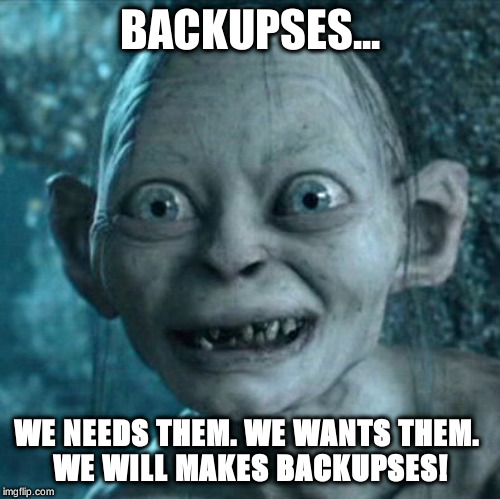So that’s basically it, I’m new to manjaro KDE, but I see various posts all over the internet about “system crash after update…” And it makes me uncomfortable because I’m not an advanced user to solve these kinds of problems. But at the same time, I need kernel 5.18, so ubuntu, fedora, open suse can’t fit on my computer, otherwise my computer won’t shut down properly. Ah, how long have you guys been using Manjaro/Arch based distros without any post-update problems?
There is - usually - only post-update problems if you have customized your system heavily.
Just like Arch - custom packages are unsupported - and Manjaro is as stable as Arch - suffice you know what you are doing.
Enlighten yourself on best practise for updates
A few basic rules - if you want to avoid breakages
- Do not stray from upstream
- Do not exagerate custom packages
- Do not employ all likes of custom themes
Ever since I first installed it, late April 2019. There have been some minor niggles, but never any crashes, and I was always able to solve things.
For that matter, it is important to keep an eye on the #announcements category, because every bundled update always comes with an announcement thread, in which @philm or one of the other team members highlights the changes, the possible caveats, and how to solve them or work around them.
That said, Manjaro is a rock-solid distribution. But you do have to keep it updated, and you do have to keep your head on your shoulders, because a large amount of the problems we see being reported here are from people who did not pay any attention to the announcements, and who did not do a search on the forum before posting — and who thus end up asking questions that have been answered a gazillion times already — and/or who got themselves into trouble because they’re used to Microsoft Windows, and who therefore think that what applies to Windows also applies to GNU/Linux.
I haven’t had any post-update issues in the ~2 years I have been using Manjaro.
To me, it seems a lot of issues people have following an update are related to NVIDIA drivers. I am AMD CPU and GPU and, as I said, had no issues.
You can have 5.18 kernel on all these distributions.
And I’d add to that…:
-
Avoid third-party software and do not blindly install software from the vendors’ websites. Most of the software you need or may want is available from the repositories and from the AUR.
-
Don’t follow any YouTube videos on how to do something. Read the documentation first, and if not sure how to proceed, come and ask us about it here.
-
Don’t try installing any Ubuntu, Debian, openSUSE or Fedora packages, and don’t follow any advice on the web for Ubuntu, Debian, openSUSE, Fedora, or whatever. The only distributions that come somewhat close to Manjaro are the ones based upon Arch, but even then there may still be important differences.
MANJARO IS…
AND DON’T FORGET… 

To make it easy:
Look after Manjaro, and it’ll look after you!
That also means that if you don’t, you’ll have headaches.
There have been a few dramas in the past. Sometimes the Manjaro team makes a decision to include something, and a few purists start complaining… many of them quit and moved on to other distributions but still have loud complaining voices.
Personally I had a few problems - usually caused by AUR packages which need rebuilding, and just about all of them disappeared if I created a fresh ‘TEST’ user and logged into that - unless I’d messed around with system files and properly messed it up.
So I think I can say in 5 years, Manjaro never caused me to crash or fix anything that they broke… Yet if you mention this on Reddit, you get downvoted like crazy. Lots of drama queens on Reddit.
My PC is vital for family life, it manages all the media for the house, with the exception of my wife’s Netflix subscription on the TV downstairs.
Common sense tells us that if we’re going to play with the system, and we’re gonna break it… so we should have a good strategy.
I’m content to live with daily Timeshift snapshots, and Back-in-Time (both rsync to my mounted hard disk). That also means that when I really do manage to mess it up, I can throw in a USB, install (about 5 minutes) and restore (another ten minutes).
So really, it’s up to you dude. I learned to have my backups since I messed up my Linux Mint installation a few times and that’s when I started with Timeshift - so I just don’t really care anyway.
I have never had the system crash after an update. I have been running Manjaro LXQt stable for about 4.5 years. I have even themed the system, including grub, with my own custom themes. A little bit of advice, never use AUR packages for system components unless absolutely necessary. Stick to LTS kernels unless absolutely necessary. Use Timeshift in case an upgrade goes bad.
< off-topic >
I can’t speak for backintime, nor for periodically run timeshift, but in the manually run timeshift (with rsync), there is a new feature now — or at least, ever since a few months ago — i.e. the target filesystem doesn’t have to be mounted; timeshift will automatically mount and unmount the target filesystem all by itself. ![]()
< /off-topic >
They even removed the post in reddit hahahahaha
Not a (and never have been) a fan of timeshift. That said:
Add a caveat here: Need to test and ensure that it’s mounting and saving to the correct target.
It does on my system. ![]()
I’d also say there is some hardware that is more of a hassle. Nvidia for example. You just don’t see many problems with Intel HD video. Weird dongle/USB based wifi cards. Bluetooth is trouble, not just Linux, but Windows and even in my car. Those are the ones that stick out.
I use timeshift and it saves to my internal backup drive on schedule whether it is mounted or not.
Actually, rather than read this thread - go read the ‘UGRADE’ threads. There you find a concentrated list of real issues, and (out of hundreds of thousands of users) of people who actually had issues.
A few have genuine issues. For many, it’s a bit of a facepalm moment.
Maybe we should have a new Meme…
“wut, you’re saying it’s MY fault that your operating system fails when I drop my laptop in the bath!!!”
Haha yes, sorry - bit early in the morning…
Update threads in Announcements.
One time I went about 3 months without an update breaking my installation, another time I went 2 years without an update breaking my installation.
Right now I’ve been on the same manjaro installation for about a year and I haven’t had anything happen (honestly I’m starting to think that updates causing crashes is a thing of the past for manjaro)
If you’re worried about it though, all you have to do is read through the update post (which you by default get notified about through that manjaro tray notification thingy) whenever there’s a big update (about twice a month?)
In there you will almost certainly get warned about any potential breakage and can thus prevent it.
I think there might also be cause for worry if you have not updated for a couple months and then one day decide to do a full system update (although I’ve done such an update after like a year and everything worked fine so it’s not a sure thing, just increases the odds of something going wrong).
The simpliest way i do now is to simply wait a day or few more, reading the posts at the forum, if the update cause problems. And if anything is quiet, i start the update. That worked the last times pretty well ![]()
